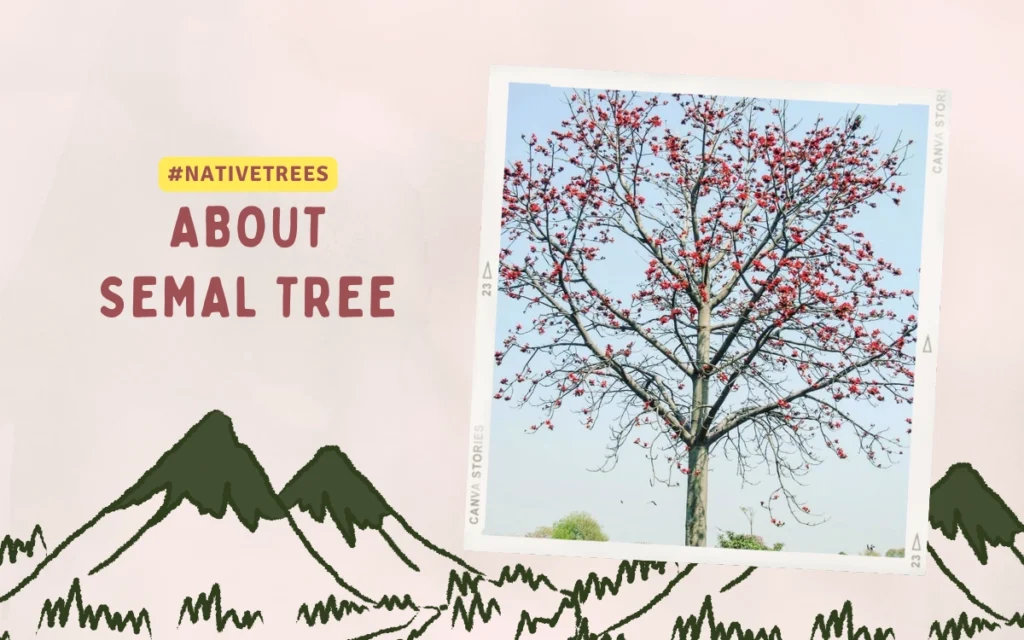The Majestic Semal: Guardian of the Forest

1. Introduction:
The Semal tree, scientifically known as Bombax ceiba, stands as a symbol of resilience and cultural significance in the Indian subcontinent. Its majestic presence and deep-rooted symbolism make it a cornerstone of both natural ecosystems and cultural heritage.
2. Scientific Classification:
The semal tree is classified universally with such distinctions:
- Kingdom: Plantae
- Phylum: Angiosperms
- Class: Eudicots
- Order: Malvales
- Family: Malvaceae
- Genus: Bombax
- Species: Bombax ceiba
Semal Tree
3. Description:
The semal tree stands majestic with its vibrant red-orange blossoms, characterized by a sturdy trunk and broad, lush foliage, symbolizing resilience and vitality in its environment.
1. Height: The Semal tree, reaching towering heights between 20 to 30 meters, stands as a majestic presence in its habitat, drawing attention with its impressive stature and dominating the canopy with its lofty branches.
2. Trunk Diameter: Characterised by its robust and sturdy trunk, the Semal tree boasts diameters ranging from 1 to 2 metres, serving as a testament to its resilience and strength, anchoring firmly in the earth and providing stability to the surrounding ecosystem.
3. Leaves: Adorned with glossy green palmate leaves composed of 5 to 7 leaflets, the Semal tree presents a verdant canopy that not only offers respite from the sun but also serves as a vital source of nourishment and habitat for countless organisms, enriching the biodiversity of its environment.
4. Flowers: In the dry season, the Semal tree bursts into a dazzling display of vibrant crimson flowers, adorning its branches and attracting a myriad of pollinators with their captivating beauty and sweet nectar, thereby adding a splash of colour to the landscape and marking the onset of seasonal change.
5. Fruits: Following the flowering period, the Semal tree produces woody capsules containing seeds that are dispersed by the wind, ensuring the tree’s propagation and contributing to the continuity of its species within the ecosystem, thereby perpetuating its legacy for generations to come.
Semal Tree Fruit
4. Distribution and Habitat:
Semal trees (Bombax ceiba) are native to the Indian subcontinent, including various regions of India, Nepal, and Bangladesh. They are widely distributed across the following geographical areas:
1. India: Semal trees are found throughout India, from the northern Himalayan foothills to the southern Western Ghats. They thrive in diverse habitats, including tropical and subtropical forests, riparian zones along riverbanks, and even urban areas with adequate moisture and sunlight. Some of the states in India where Semal trees are commonly found include Uttar Pradesh, Madhya Pradesh, Bihar, West Bengal, Maharashtra, and Karnataka.
2. Nepal: Semal trees are also native to Nepal, where they are found in lowland forests, foothills, and along riverbanks. They contribute to the biodiversity and ecological integrity of Nepal’s forested landscapes, providing habitat for wildlife and supporting local livelihoods.
3. Bangladesh: In Bangladesh, Semal trees are distributed in various regions across the country, including forested areas, riverine habitats, and urban green spaces. They are valued for their ecological importance, cultural significance, and economic benefits to local communities.
Additionally, Semal trees have been introduced to other parts of the world, including Southeast Asia, Africa, and the Caribbean, where they are cultivated for their ornamental value and various practical uses. However, their natural distribution is primarily limited to the Indian subcontinent, where they play a vital role in local ecosystems and cultural traditions.
5. Lifespan:
Semal trees, boasting a lifespan of over a century, symbolize enduring strength and tenacity in nature’s tapestry. Standing as venerable sentinels, they weather the passage of time, embodying resilience amidst the changing seasons. Their longevity serves as a testament to the profound interconnectedness between life and time, fostering a deep reverence for the wisdom found in the silent growth of ancient arboreal guardians.
6. Ecological Importance:
The semal tree is ecologically vital, providing habitat, food, and nesting sites for diverse wildlife. Its deep roots stabilize soil, prevent erosion, and contribute to carbon sequestration, enhancing biodiversity and ecosystem health.
1. Soil Stabilisation: Semal’s deep-reaching roots intricately weave through the earth, steadfastly anchoring the soil, thereby curbing erosion and fostering a stable foundation. Moreover, its root system enriches the soil with vital nutrients, nurturing a fertile environment crucial for sustaining diverse ecosystems and promoting overall soil health.
2. Wildlife Habitat: Beneath the expansive canopy of Semal trees, a vibrant ecosystem thrives, offering refuge and nesting sites for an array of wildlife species. From birds to small mammals, this verdant haven provides essential shelter and sustenance, fostering biodiversity and ecological balance in the surrounding habitat.
3. Pollinator Support: Bursting into a spectacular display of vibrant blooms, Semal trees beckon pollinators with their sweet nectar and enticing fragrance. Bees, butterflies, and other pollinating insects flock to these blossoms, engaging in essential pollination activities that facilitate the reproduction and genetic diversity of numerous plant species, thus perpetuating the intricate web of life.
4. Carbon Sequestration: Towering majestically, Semal trees stand as silent sentinels in the fight against climate change, actively sequestering carbon dioxide from the atmosphere through the process of photosynthesis. Their robust biomass acts as a reservoir for carbon, helping to mitigate the impacts of greenhouse gas emissions and contributing to the restoration and preservation of environmental balance on a global scale.

Semal Tree flower
7. Cultural Significance:
The semal tree holds deep cultural significance, revered for its symbolism of strength, longevity, and resilience in many indigenous traditions. It often serves as a gathering place for communities, a site for ceremonies, and a symbol of connection to nature and ancestral heritage.
1. Folklore and Traditions: Embedded deeply within the tapestry of Indian folklore, Semal trees are revered symbols of resilience, embodying both the strength of nature and the allure of natural beauty. Legends and tales narrate their steadfastness, weaving tales of endurance and the timeless connection between humanity and the environment.
2. Traditional Uses: Semal’s versatile attributes have long been intertwined with traditional practices, with its timber utilized in construction, its fibres woven into textiles, and its medicinal properties harnessed in various remedies. Across generations, communities have relied on Semal for sustenance, shelter, and healing, honouring its multifaceted contributions to daily life.
3. Festivals: As Semal trees burst into a vibrant display of blossoms, their blooming heralds the onset of joyous festivities across India, marking a time of renewal and vitality. From the colorful festivities of Holi to the auspicious celebrations of Basant Panchami, Semal’s emergence signals the rejuvenation of nature and the spirit of communal revelry.
8. Threats and Conservation:
Threatened by habitat loss and climate change, semal trees require conservation efforts such as habitat restoration and community education to safeguard their ecological importance and cultural significance.
1. Urbanisation: The swift sprawl of urban areas encroaches upon Semal habitats, resulting in the loss and fragmentation of their natural environments, endangering the survival of these iconic trees and the diverse ecosystems they support.
2. Deforestation: Rampant clearing of forests for agricultural expansion and urban development poses a significant threat to Semal populations, leading to habitat destruction and a decline in biodiversity, ultimately disrupting the delicate ecological balance.
3. Climate Change: The erratic shifts in weather patterns induced by climate change disrupt Semal’s flowering cycles, impacting pollination and seed dispersal, thereby necessitating adaptive conservation strategies to mitigate the adverse effects and ensure the resilience of Semal populations in the face of environmental instability.
4. Conservation Efforts: Collaborative endeavors in reforestation and community engagement initiatives strive to safeguard Semal populations and their habitats, fostering a collective commitment to preserving these invaluable natural resources and nurturing sustainable coexistence between human development and biodiversity conservation.

Tree Conservation
9. Facts about the Semal Tree:
1. Medicinal Uses: Various parts of the Semal tree, including the bark, leaves, and flowers, are utilized in traditional medicine for their therapeutic properties. They are used to treat a range of ailments such as cough, fever, skin diseases, and gastrointestinal issues.
2. Fibre Production: The fibers extracted from Semal fruits are used in the textile industry for making ropes, mats, and traditional textiles. These fibres are known for their strength and durability, making them valuable resources for local communities.
3. Timber Quality: The timber of the Semal tree is highly valued for its durability and resistance to decay. It is used in construction, furniture making, and boat building industries, contributing to local economies and livelihoods.
4. Longevity: Semal trees are known for their longevity, with some individuals living for over a century under favourable conditions. Their enduring presence in landscapes symbolises continuity and resilience in the face of environmental changes.
10. Planting Tips:

Planting Semal trees requires careful consideration of various factors to ensure their successful establishment and growth. Here are some planting tips for Semal trees:
1. Selecting the Planting Site:
1.Choose well-drained soil with full sun or partial shade.
2.Ensure ample space away from structures, power lines, and other trees.
2. Preparing the Soil:
1.Loosen soil for better aeration and drainage, removing weeds and debris.
2. Add organic matter like compost to improve fertility and moisture retention.
3. Planting Technique:
– Dig a hole 2-3 times wider than the root ball and of similar depth.
– Place the tree in the centre, ensuring the root ball is level with the soil surface.
4. Backfilling and Watering:
1.Backfill soil, firming it around the roots and water thoroughly.
2.Apply mulch around the base, keeping it several inches away from the trunk.
5. Watering and Maintenance:
1.Water regularly, especially during dry periods, to keep soil moist.
2.Prune damaged branches, monitor for stress, and fertilise annually.
6. Protection from Pests and Diseases:
1.Monitor for pests and treat promptly using eco-friendly methods.
2.Maintain good sanitation by removing fallen leaves and debris.
By following these planting tips, you can ensure the successful establishment and growth of Semal trees in your landscape, providing beauty, shade, and ecological benefits for years to come.
Let’s wrap it all:
The Semal tree epitomizes the intricate bond between nature and culture, embodying resilience and interconnectedness. By understanding its ecological importance and advocating for conservation, we ensure its enduring legacy in our natural and cultural landscapes.